Costa Rica, a jewel of Central America, has long been renowned for its natural beauty, but it’s also a treasure trove when it comes to coffee. Often overlooked in favor of more famous coffee-producing regions, Costa Rica holds its own with unique, flavorful beans that are considered some of the finest in the world. In this article, we take you on a journey through the rich, aromatic world of the best Costa Rican coffee. We’ll delve into standout offerings from leading Costa Rican coffee brands, exploring their unique flavor profiles, processing methods, and commitment to quality and sustainability.
Whether you’re a casual coffee drinker or a seasoned connoisseur, you’ll discover something that suits your palate, all the while gaining a deep appreciation for the robust complexity of Costa Rica coffee beans. From the celebrated Costa Rican Tarrazu to the ethical practices of Java Planet, prepare to be enthralled by Costa Rica’s coffee culture.
Costa Rican Coffee: Key Takeaway
- Historical Importance: This delectable coffee has a rich history dating back to the 17th century and has played a significant role in shaping the country’s economy and cultural identity.
- Diverse Growing Regions: Different regions in Costa Rica, such as Tarrazú and Guanacaste, offer unique flavor profiles, making this beverage a diverse and exciting experience for the palate.
- Complex Flavor Profile: This coffee drink is known for its well-balanced characteristics, including acidity, body, and distinct flavors, influenced by both the varietals grown and the processing methods employed.
- Brewing Techniques: From traditional methods like the chorreador to modern coffee makers, there are various ways to brew the perfect cup of this lovely drink to enjoy its rich, authentic flavors at home.
- Economic and Cultural Impact: Coffee isn’t just a crop in Costa Rica; it’s a cultural phenomenon that has funded infrastructure projects, influenced societal norms, and continues to be a significant part of the country’s exports.
Best Costa Rican Coffee Brands
When it comes to selecting the best Costa Rican coffee, connoisseurs often find themselves spoiled for choice. Costa Rica, a small country blessed with an idyllic coffee-growing environment, produces some of the world’s most vibrant and sophisticated coffees. Today, we’ll dive deep into an array of distinctive brands and blends, each representing the apex of this beverage culture. Specifically, we will review Volcanica Costa Rica Geisha Coffee, Costa Rican Tarrazu Coffee by Fresh Roasted Coffee Company, Java Planet Organic Costa Rica Single Origin, and more. These Best Coffee Brands epitomize the diverse flavors and processes that make this coffee so exceptional.
Volcanica Costa Rica Geisha Coffee

Volcanica’s Costa Rica Geisha Coffee is a bean that captivates your senses before the first sip even touches your lips. Originating from the venerable Finca La Candelilla, this coffee is more than just a beverage; it’s an experience, a testament to Costa Rica’s rich coffee history. Presenting an uncommon variety of Geisha, this unique discovery possesses a reduction of 30% in caffeine content. However, it steadfastly maintains its rich taste profile, presenting a delightful array of sweet, tangy, apple-like, and floral characteristics.
- Taste Profile: Sweet, Tangy, Apple-like, and Floral Notes
- Processing: Method of Natural Processing
- Roast: Medium/Light Roast
- Farm: Finca La Candelilla
- Microlot: Yes
- Natural Process: Sun-dried on raised beds for 8-12 days; results in sweeter, more floral flavors
Why choose this coffee? For one, it’s an alliance between Volcanica and La Candelilla Farm, ensuring impeccable quality and ethical sourcing. Every cup is like sipping on history and tradition. The natural processing method preserves the complexity of flavors, making it a perfect choice for those who enjoy a lively yet delicate cup of coffee.
Volcanica Finca Las Mercedes Costa Rican Coffee
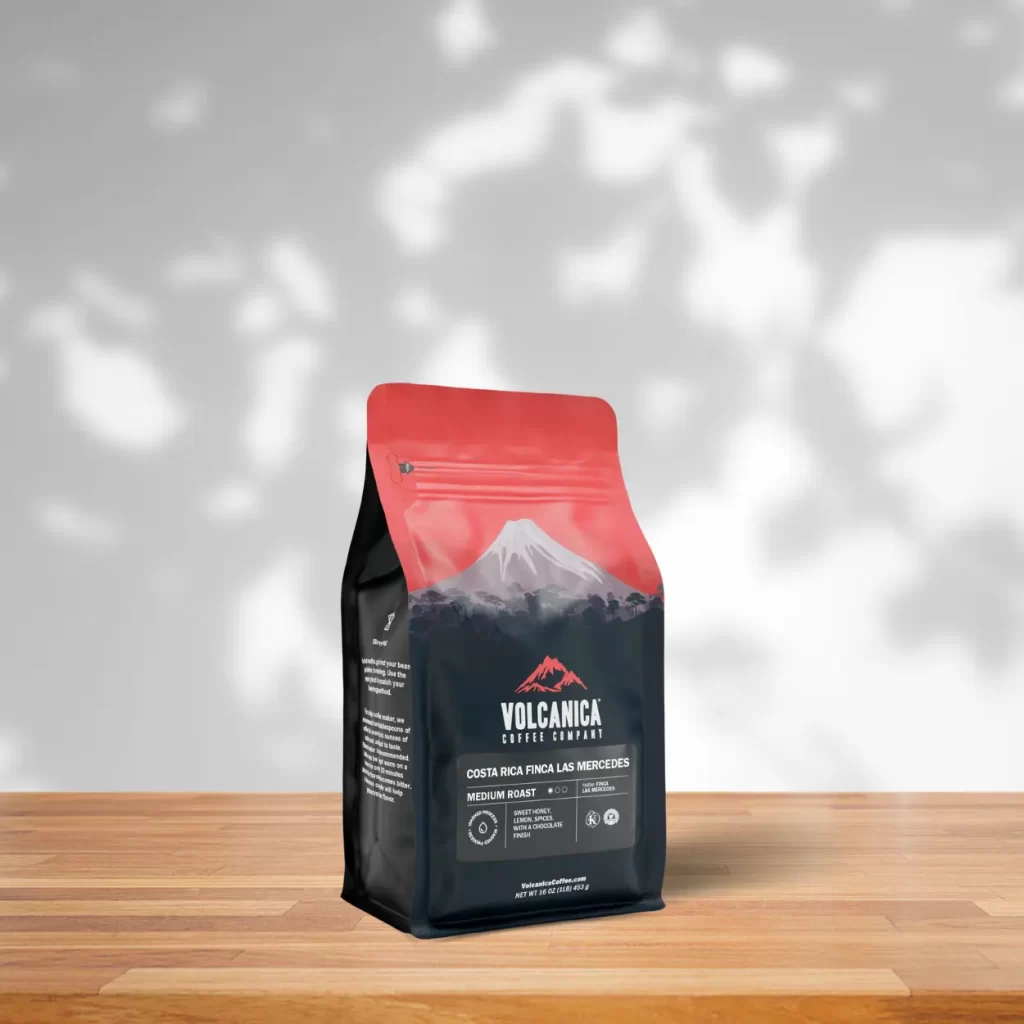
Another gem from Volcanica Coffee Company, the Finca Las Mercedes Costa Rican Coffee originates from the plush mountains of Tarrazu, one of the finest coffee-growing regions in the world. Mela Gamboa and Luis Rojas, third-generation farmers, have imbued their expertise into the development of this blend, creating a cup that’s not just flavorful but emotionally resonant.
- Flavor Notes: Pineapple, Blackberry Jam, Sweet Tea, and Peach Candy
- Processing: Natural Process
- Roast: Light Roast
- Drying: Patio
- Farm: Las Mercedes Coffee Farm
- Certifications: Direct Trade
This is the coffee for those who appreciate a nuanced blend of fruity and sweet notes. The natural processing allows the coffee beans to absorb rich, flavorful nutrients, resulting in a bright, fruit-forward cup. With direct trade certification, it’s also a conscious consumer’s choice, making every cup as ethical as it is delicious.
Volcanica Peaberry Coffee Costa Rica
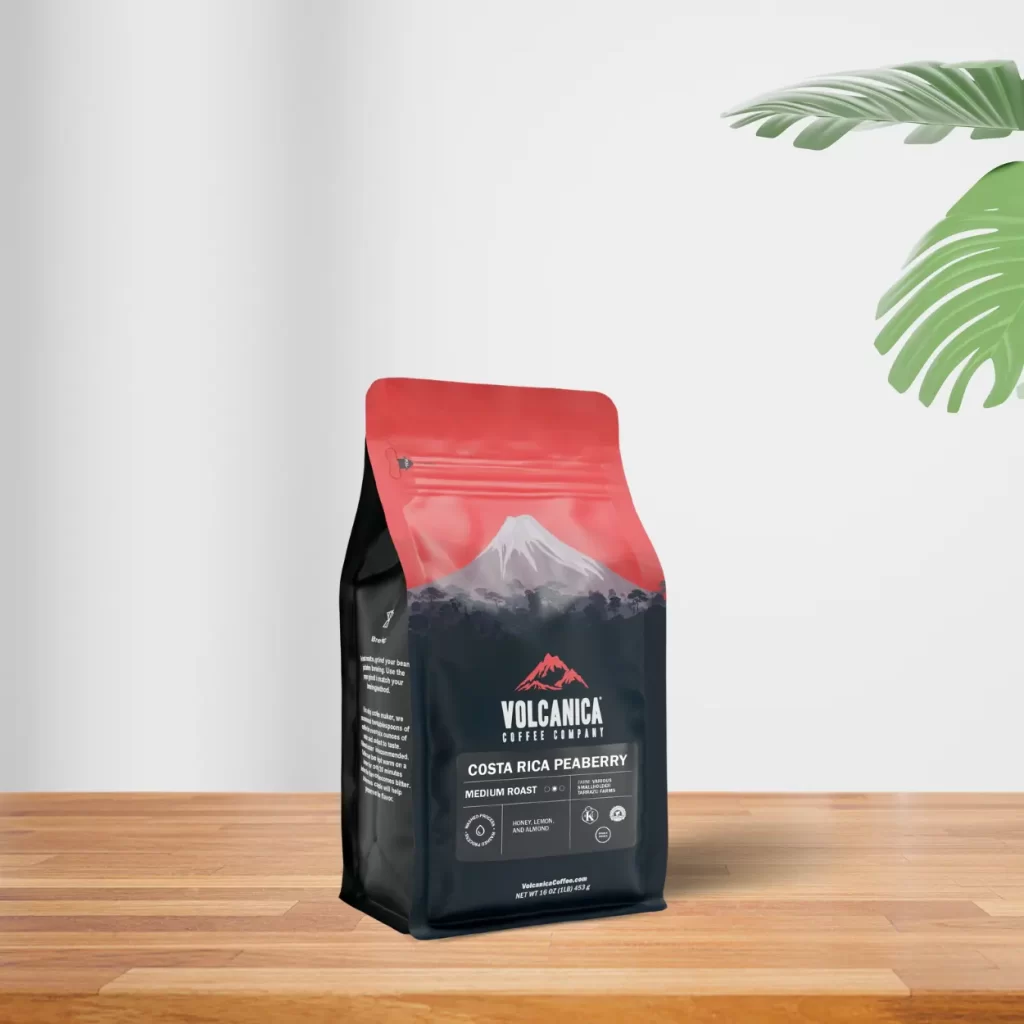
If you’re searching for a coffee that’s more than just a drink but an emotional journey, Volcanica’s Peaberry Coffee from Costa Rica is your elixir. Sourced from the Tarrazu region near San Marcos, as well as La Candelilla Estate. The washed processing of the coffee cherries amplifies the brightness and complexity of the cup, embodying the best Costa Rican coffee.
- Flavor Notes: Honey, Lemon, and Almond
- Processing: Washed Process
- Roast: Medium Roast
- Drying: Patio
- Farm: Coopetarrazu and Finca La Candelilla
- pH: 5.1
- Single Origin: Yes, grown at an altitude of about 5,200 feet
What makes this coffee exceptional is its single-origin status, grown in high-altitude volcanic soils, resulting in a bean that’s as unique as it is flavorful. Its flavor profile is strikingly similar to Finca Las Mercedes, yet the Peaberry bean itself—a rare mutation in which a coffee cherry produces a single, rounded bean instead of two flat ones—brings a different level of smoothness and intensity. Simply put, it’s the epitome of luxury in a cup.
Costa Rican Tarrazu Coffee by Fresh Roasted Coffee Company
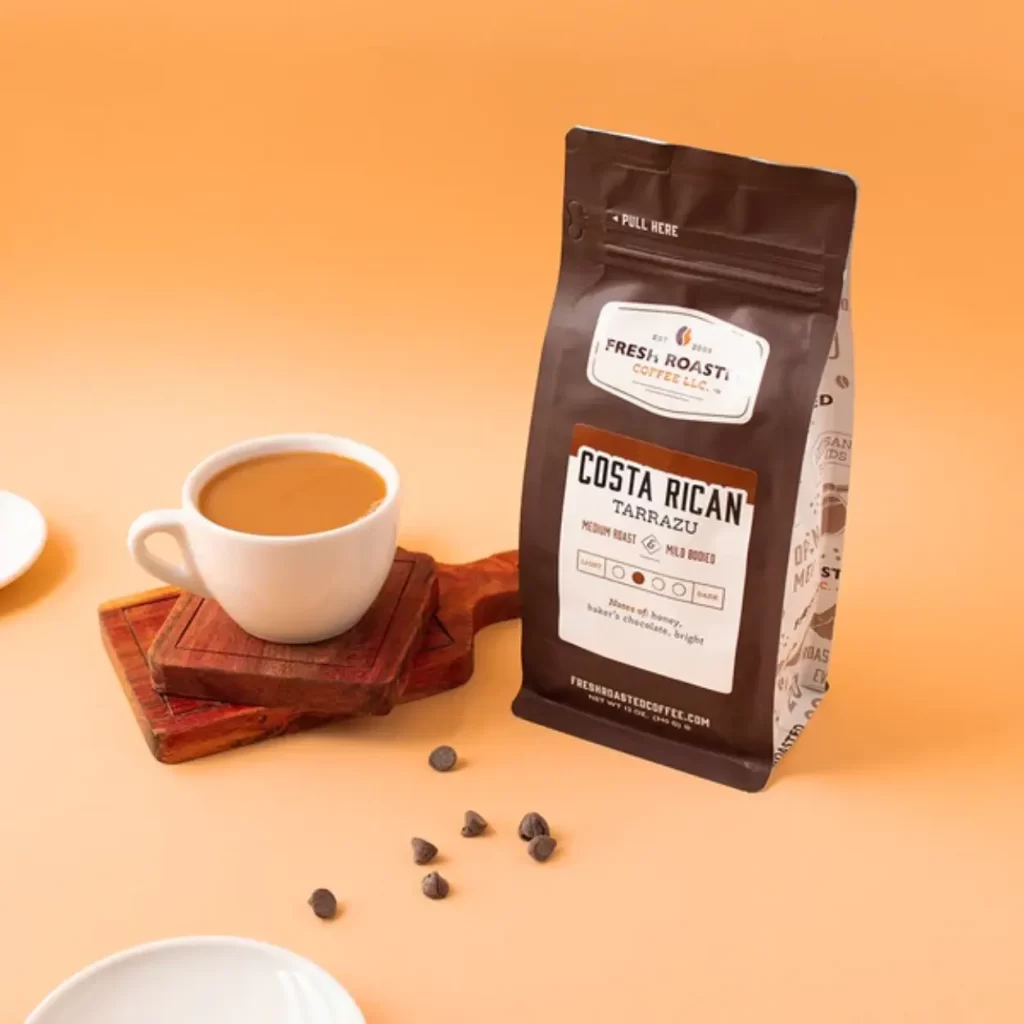
When one speaks of premium coffee from Costa Rica, the Costa Rican Tarrazu by Fresh Roasted Coffee Company inevitably finds its way into the conversation. This medium-roast coffee is an intricate blend of art and science, grown at elevations ranging from 1,300 to 1,600 meters, and then meticulously processed using the fully washed method.
- Flavor Notes: Honey and Chocolate
- Processing: Fully Washed
- Roast Level: Medium Roast
- Varietals: Caturra and Catuai
- Altitude: Grown at 1,300-1,600 meters
- Packaging: Available in 12 oz, 2 lb, and 5 lb Whole Bean Bags
- Sustainability: Proudly Roasted, Blended, and Packaged in the USA
If you are a coffee enthusiast looking for a cup that strikes the perfect balance between boldness and subtlety, then this is the coffee you need to explore. The brand brings to the table over a decade of roasting experience, employing an environmentally-friendly Loring Roaster. The end result is a cup so vivid and full-bodied that you’ll question why you ever settled for anything less.
Café 1820 Costa Rican Coffee

If you’re a seeker of dark roast coffee, Café 1820 is a quintessential choice. Grown in volcanic soils at altitudes above 1,100 meters, every cup of this coffee offers a symphony of balanced acidity and a tantalizing touch of sweetness. The brand, a staple in Costa Rica, lives up to its reputation by delivering a full-bodied, exceptionally fresh coffee experience that’s perfect for any time of day.
- Flavor Notes: Fruity Notes Complemented by Hints of Chocolate
- Roast Level: Dark Roast
- Altitude: Grown at more than 1,100 meters above sea level
- Packaging: Can
- Freshness: Exceptional Freshness Guaranteed
- Compatibility: Compatible with Any Coffee Maker
What sets Café 1820 apart is the remarkable consistency in its flavor profile, something that only the best Costa Rican coffee brands can achieve. If you’re looking for an aromatic and deeply satisfying cup of coffee, don’t overlook Café 1820.
Java Planet Organic Costa Rica Single Origin
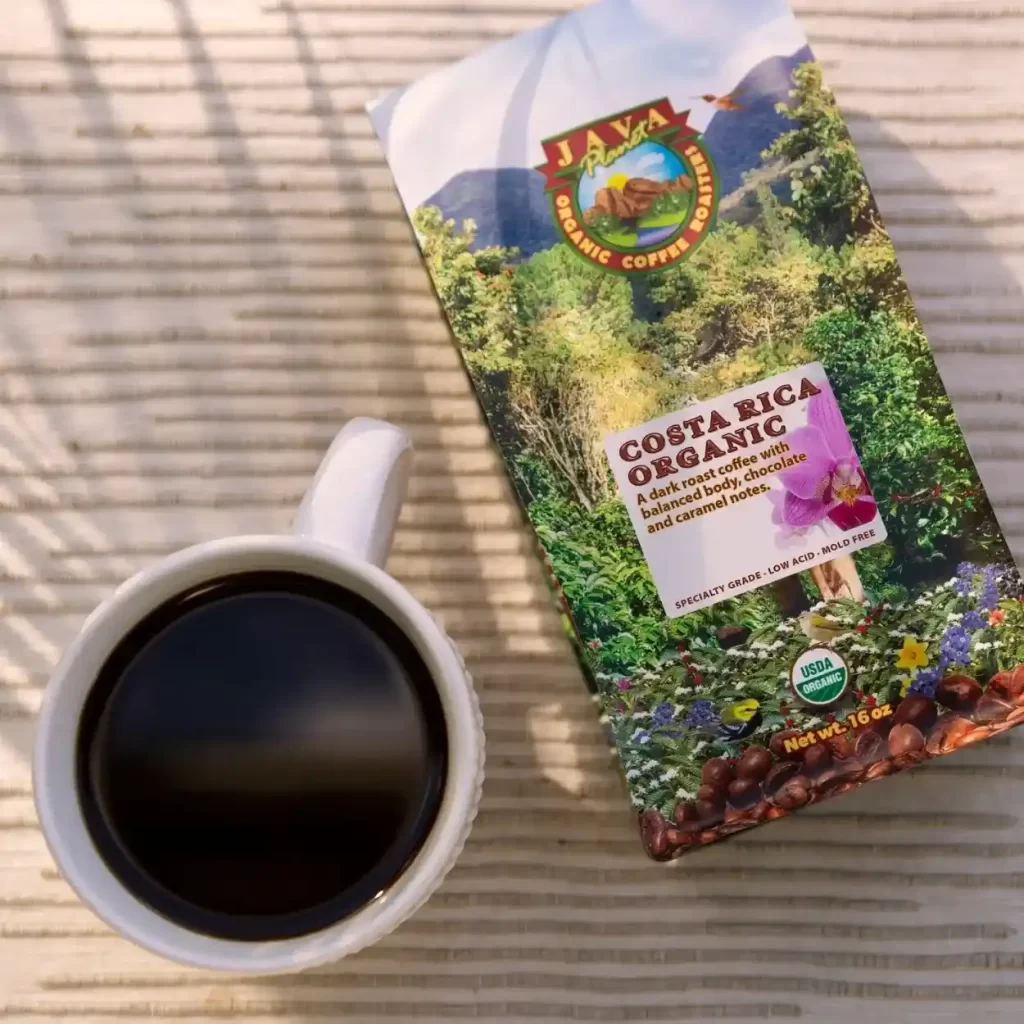
Java Planet Organic Costa Rica Single Origin coffee is a dark roast that stands out for its environmental and social responsibility. Unlike many brands on the market, Java Planet is committed to using 100% organic specialty-grade arabica coffee beans that are free of pesticides and mycotoxins. This ensures that you are consuming a healthier cup of coffee, packed with the beneficial antioxidants naturally found in coffee grown at high altitudes.
- Flavor Notes: Chocolate and Caramel with a Light Citrus Note
- Processing: 100% Organic Specialty Grade Arabica Coffee Beans
- Roast Level: Dark Roast
- Sustainability: Socially and Environmentally Responsible Farming
- Packaging: Bag
- Family-owned: Committed to Customer Satisfaction
Dark-roasted to perfection, this coffee unleashes an array of chocolate and caramel flavors, capped with a light hint of citrus. Whether you use a drip, pour-over, or French press, this coffee will not disappoint. Its commitment to quality and strong ethical grounding make it a standout choice for any coffee connoisseur.
By exploring any of these exemplary brands, you’ll surely develop a deep appreciation for the rich palette of costa rica coffee beans. From the celebrated Costa Rican Tarrazu Coffee to the sustainably sourced offerings of Java Planet, the world of coffee from Costa Rica offers something for every palate.
The Rich History of Costa Rican Coffee
This delightful beverage is woven into the very fabric of the country’s history, economy, and culture. From its early beginnings in the Meseta Central to the establishment of Costa Rica as a reliable coffee powerhouse, the journey is filled with innovation, crisis, and revival. This section seeks to provide a comprehensive look at the evolution of coffee production in Costa Rica and its economic implications.
Early Beginnings and Coffee’s Introduction to Costa Rica

Coffee made its debut in Costa Rica in the 17th century, a relatively late arrival compared to its introduction in other Central American nations. The conditions in the Meseta Central, an elevated plateau, proved ideal for the cultivation of Coffea arabica, a species initially from Ethiopia. The Costa Rican government, sensing an opportunity for economic growth, encouraged coffee cultivation through land grants. These policies, though criticized for favoring the elite, laid the groundwork for the coffee industry.
- Initiation Year: 1779
- Key Coffee Varietal: Coffea arabica
- Government Incentives: Land grants for farmers
- Primary Growing Areas: Meseta Central
The Golden Era of Coffee in Costa Rica
The 19th century ushered in what many consider the “Golden Era” of coffee in Costa Rica. Trade routes were established, first through middlemen in Chile and later directly to the United Kingdom. British investment soared, marking a significant turning point in the coffee industry. The revenues from coffee exports led to a cascade of developments including railroads and even the construction of the National Theater in San José. During this period, coffee surpassed other crops like cacao, tobacco, and sugar, and became an essential part of the Costa Rican economy. (1)
- Key Trade Partners: Initially Chile, later the United Kingdom
- Major Developments: National Theater, Atlantic Coast railroads
- Dominance Over Other Crops: Surpassed cacao, tobacco, and sugar by 1829
- Financial Institutions: Establishment of Anglo-Costa Rican Bank in 1863
Modern-Day Coffee Production and its Economic Impact
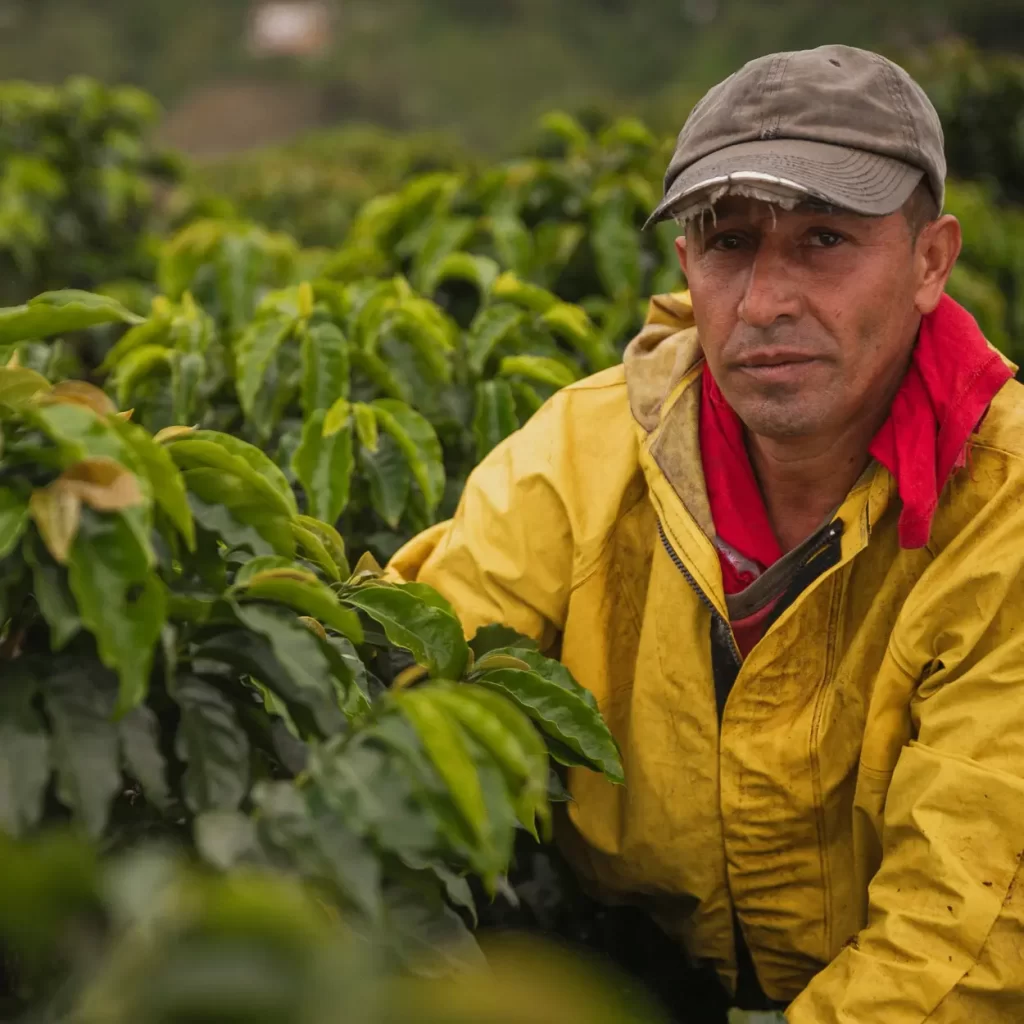
Despite its modest contribution to global coffee output—under 1%— this coffee remains an important facet of the country’s economy. Although urban sprawl and real estate development have curtailed coffee farming in certain areas, the sector continues to adapt and innovate. Unfortunately, fluctuating global coffee prices and trade policies have had a more pronounced impact on Costa Rica than on larger producers. The country has been part of various international coffee retention plans to stabilize prices and continues to explore sustainable, high-quality production methods to maintain its competitive edge.
- Current Global Contribution: Under 1%
- Modern Challenges: Urban sprawl, fluctuating global prices
- Wage Concerns: Low pay for seasonal workers, often Nicaraguan immigrants
- Environmental Concerns: Impact of pulp removal at beneficios (processing plants)
By appreciating the journey coffee has made through Costa Rican history, one gains a nuanced understanding of not just a beverage, but a symbol of national identity.
Unique Coffee Growing Regions of Costa Rica
The splendor of this beverage is deeply rooted in the varied landscapes that serve as its cradle. From the high-altitude regions of Tarrazú to the tropical lowlands of Guanacaste and the untamed terrains of Brunca, each area contributes a unique character to its beans. Let’s explore these distinct coffee-growing regions and what makes their flavors so remarkable.
The Character of Tarrazú Coffee
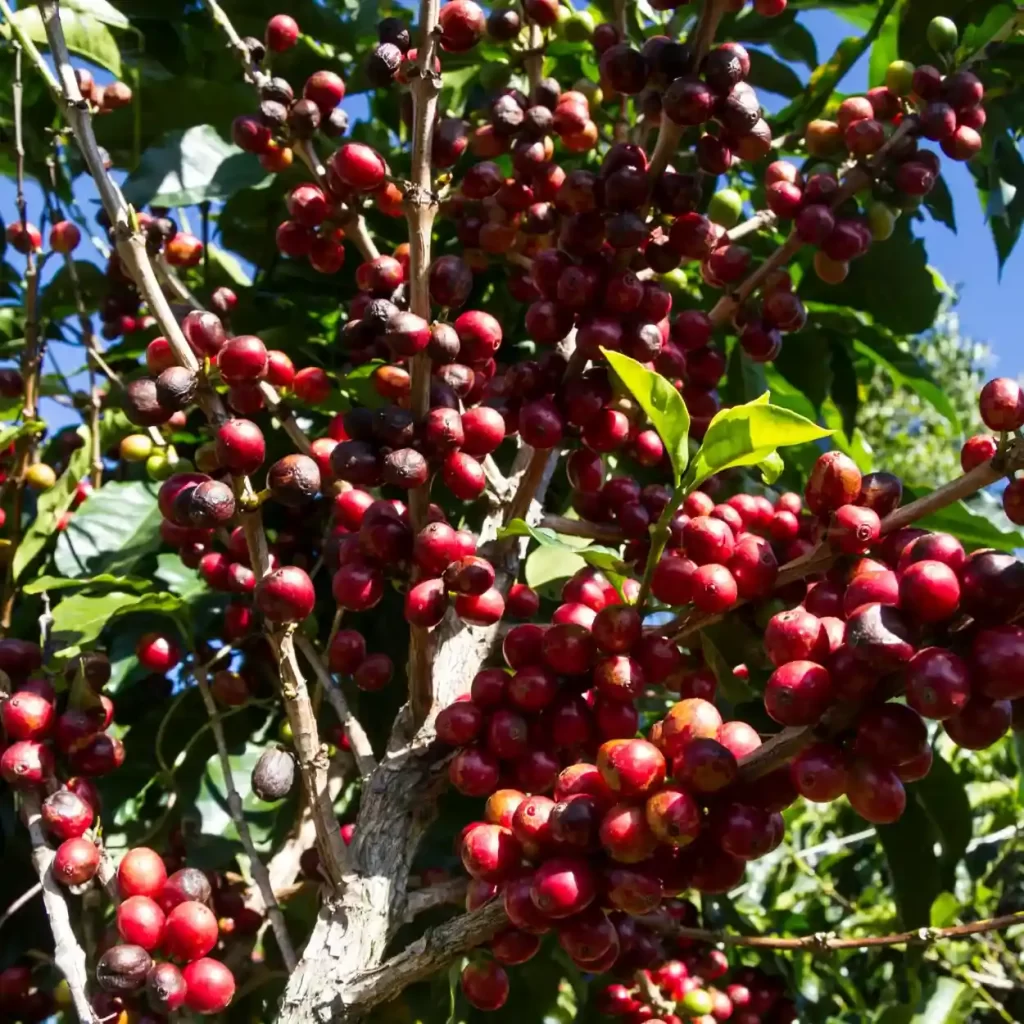
Nestled in the heart of the country, the Tarrazú region is often referred to as the “Bourbon belt of Costa Rica.” Known for producing some of the finest coffee beans in the world, Costa Rican Tarrazú coffee is highly sought after by connoisseurs. The region benefits from volcanic soils, high altitudes, and a distinct dry season, which combine to produce beans with bright acidity, deep body, and citrus-like flavors.
- Altitude: Typically grown at elevations of 1,200 to 1,800 meters
- Soil Type: Volcanic
- Climate: Defined dry and wet seasons
- Flavor Profile: Bright acidity, full-bodied, notes of citrus
The Distinctive Profile of Guanacaste Coffee

The province of Guanacaste, located in the northwestern part of Costa Rica, offers a completely different coffee experience. Known for its tropical dry forests and hotter temperatures, Guanacaste’s coffee is often characterized by a lighter body and nuttier flavors. The beans from this region are commonly used for blends, contributing balance and smoothness.
- Altitude: Grown at relatively lower elevations, usually below 1,000 meters
- Soil Type: Loamy to sandy
- Climate: Hotter and more humid
- Flavor Profile: Light-bodied, nutty undertones, balanced acidity
Exploring the Brunca Region

Heading south, the Brunca region offers a more adventurous coffee landscape. The area is known for its diverse range of microclimates and unpredictable weather patterns, which result in a complex flavor profile for the beans. Coffee from Brunca often features rich notes of cocoa and spices, with a moderate to full body, making it a favorite among those who prefer more robust flavors.
- Altitude: Ranges widely, affecting flavor complexity
- Soil Type: Varied, from clay to volcanic
- Climate: Diverse microclimates, less predictable weather
- Flavor Profile: Rich notes of cocoa and spices, moderate to full-bodied
Whether you prefer the citrus notes of Tarrazú, the nutty undertones of Guanacaste, or the robust richness of Brunca, each region adds its own signature to the palette of this coffee drink. It’s this regional diversity that helps to make this beverage one of the most intriguing and valued in the world.
The Flavor Profile of Costa Rican Coffee
This beverage is not just another cup of joe; it’s an experience that combines unique flavors, remarkable textures, and a kaleidoscope of aromas that reveal the land’s rich history and diverse geography. In this section, we delve into the intricacies that define the flavor profile of coffee from Costa Rica, exploring aspects such as acidity, body, and varietals, as well as the impact of different processing methods.
Noting the Nuances: Acidity, Body, and Flavor

Understanding the flavor profile of this drink is akin to appreciating a complex piece of music; one must consider the acidity, body, and flavors that harmonize to create the final composition.
- Acidity: This coffee is often high in acidity, which should not be confused with being acidic. In the coffee world, acidity is desirable and lends a bright, lively quality to the brew.
- Body: Generally, this beverage ranges from medium to full-bodied, offering a satisfying, robust experience on the palate.
- Flavor: Depending on the region, the flavors can range from citrusy and fruity to chocolaty and nutty. For example, coffee from the Tarrazú region often has notes of bright citrus and berries, while beans from Guanacaste lean towards a nuttier profile.
Together, these elements combine to create a coffee experience that is full of character and depth, epitomizing the essence of Costa Rica’s varied landscapes and climates.
Popular Costa Rican Coffee Varietals

Costa Rica’s lush landscapes and commitment to quality have birthed a thriving coffee culture, rich in both tradition and taste. This dedication to excellence is evident in their careful selection and nurturing of coffee species. Years ago, a conscious decision was made by the country to discontinue the cultivation of Robusta, shifting the spotlight to the more aromatic and flavorful Arabica breeds. This choice was not merely based on taste preferences; it emphasized the crucial importance of conserving the ecosystems that underpin Costa Rica’s coffee production.
Below, we delve into some of the standout Arabica coffee varietals that have become synonymous with Costa Rican brews:
Costa Rican Varietals
- Typica: This classic varietal serves as the genetic base for many other coffee strains. Its beans are characterized by a clean taste, often with a hint of sweetness.
- Caturra: A mutation of Typica, Caturra is well-suited for Costa Rica’s climates, producing a bright and acidic cup.
- Catuai: This is a hybrid between Mundo Novo and Caturra, bearing a high resistance to wind and rain. The result is a cup with a rounded and balanced flavor.
- Villa Sarchi: Originating from Sarchi in Costa Rica, this dwarf varietal is known for its resilience. It offers a complex flavor profile, which is often citrusy with subtle hints of caramel.
- Bourbon: Another descendant of Typica, Bourbon is celebrated for its sweet and rich flavors. Its beans often carry notes of chocolate and fruit.
- Gesha (or Geisha): This varietal, with origins in Ethiopia, has found a favorable home in Costa Rica. Gesha is celebrated for its unique floral and tea-like aroma, making it a favorite among many coffee lovers.
- Villalobos: A pure Arabica varietal, Villalobos is native to Costa Rica. It’s revered for its fruity undertones and smooth finish.
The diversity in bean production in Costa Rica ensures that there’s something for every palate. This broad taste spectrum, borne from careful cultivation and preservation efforts, guarantees that the nation continues to satisfy the cravings of coffee aficionados worldwide.
How Processing Methods Affect Flavor
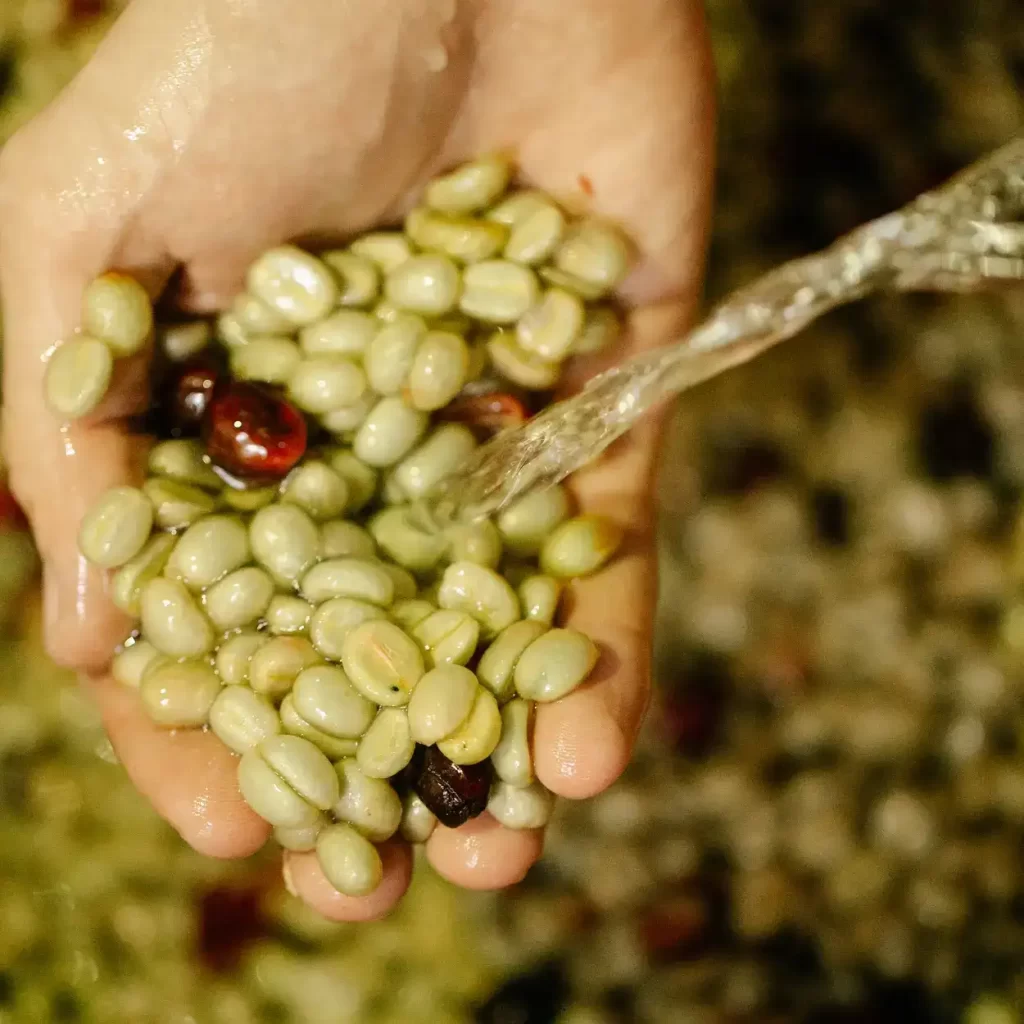
The journey of a coffee bean from farm to cup includes several critical steps, and the processing method can significantly influence the final flavor profile.
- Washed Process: This is the most common method in Costa Rica. Beans are immediately de-pulped and fermented to remove mucilage, resulting in a clean cup with bright acidity.
- Honey Process: Partial mucilage is left on the bean, allowing natural sugars to enhance the flavor. This method adds a smooth, sweet complexity to the coffee.
- Natural Process: Here, the cherries are dried whole without removing the pulp or mucilage, often resulting in a fruitier, more robust flavor.
The type of processing imparts unique characteristics, adding yet another layer of complexity to this lovely drink.
Ultimately, the flavor profile of this beverage is a fascinating interplay of acidity, body, and flavor. Coupled with the rich variety of beans and the influence of various processing methods, it creates a symphony of tastes that resonate with the coffee lover’s soul.
Brewing the Perfect Costa Rican Coffee at Home
Transforming a bag of Costa Rican coffee beans into the perfect cup of coffee can be an art form in itself. The nuances of this drink shine brightest when brewed correctly, delivering a taste experience that is both exotic and comforting. In this section, we will explore the traditional brewing techniques of this beverage, discuss the best equipment to use, and share some tips and recipes that will help you brew that ideal cup right at home.
Traditional Costa Rican Coffee Brewing Techniques

In Costa Rica, brewing coffee is a cherished tradition, passed down from generation to generation. The most iconic method is undoubtedly the use of a “chorreador.”
- Chorreador, this simple but effective brewing method involves a wooden stand that holds a cloth filter. (2)
- Coffee grounds are placed in the cloth bag, and hot water is poured over them, allowing the brewed coffee to drip into a container below.
- The chorreador method is known for yielding a smooth, clean cup that lets the coffee’s natural flavors shine.
While the chorreador method is the most traditional, Costa Ricans also make use of French presses and espresso machines to cater to a range of flavor profiles and brewing preferences.
The Best Equipment for Costa Rican Coffee
When it comes to brewing coffee from Costa Rica, the right equipment can make all the difference.
- Costa Rican Coffee Maker: Also known locally as a chorreador, as previously discussed, this is the go-to option for a traditional experience. These can often be found handmade from local artisans.
- French Press: This method allows for a more robust flavor extraction, accentuating the coffee’s body and richness.
- Espresso Machine: If you like your coffee strong and concentrated, a good quality espresso machine can bring out the complex flavors of Costa Rican beans.
- Automatic Drip Coffee Maker: For those who prefer convenience, a quality drip coffee maker with a good filter can also do justice to this drink, especially if you’re making larger quantities.
The key is to match your equipment with the specific flavor profile you’re aiming to achieve.
Tips and Recipes for Costa Rican Coffee
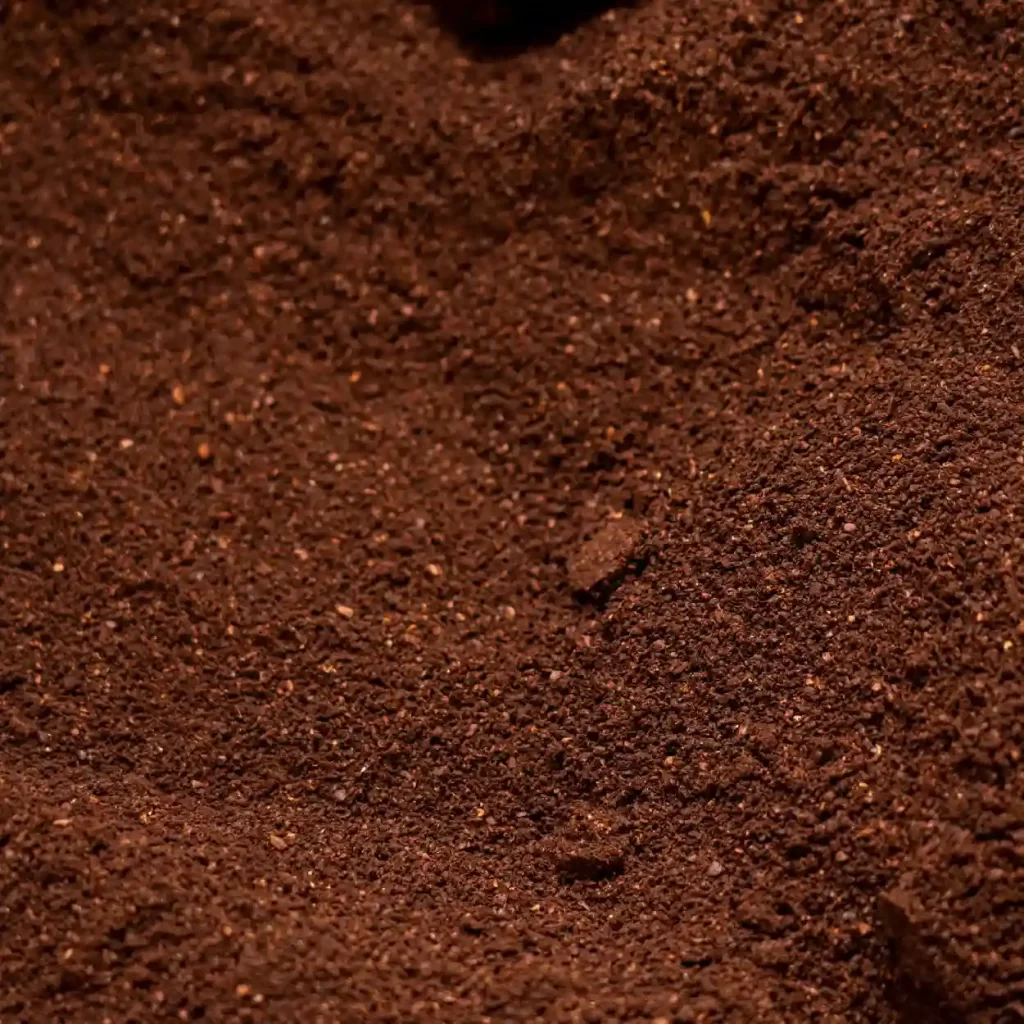
Finally, the perfect cup of this tasty coffee is within reach with a few extra tips and tricks:
- Grind Size: For a chorreador or drip coffee maker, a fine to medium-fine grind is generally recommended, while a coarser grind works well for French presses, and a fine grind is best for espresso machines.
- Water Temperature: Aim for water that is between 195°F and 205°F for optimal extraction.
- Coffee-to-Water Ratio: A general guideline is to use one to two tablespoons of coffee grounds per six ounces of water, but feel free to adjust to your taste preferences.
- Costa Rican Iced Coffee: For a refreshing twist, try brewing a strong cup of this coffee drink and cooling it down with ice. Add some sweetened condensed milk for an indulgent treat.
Experimenting is encouraged; after all, the goal is to make a cup that’s perfectly tailored to your tastes.
To sum up, whether you’re using a traditional chorreador or a modern espresso machine, understanding the nuances of this beverage and employing the right brewing techniques can make all the difference. With the right equipment and a few insider tips, you’ll be well on your way to enjoying the perfect cup of joe, right in the comfort of your home.
Conclusion
Exploring the world of this delectable coffee is like taking a flavorful journey through the rich landscapes of Central America. From its fascinating history that shaped the nation to the diverse growing regions that offer distinct flavor profiles, the best Costa Rican coffee is a tapestry of tastes and traditions. Whether you’re enamored by the acidic brilliance of beans from the Tarrazú region or you appreciate the body and complexity brought about by specialized processing methods, Costa Rica coffee beans offer something for every palate.
With the right knowledge and equipment, you can also bring the excellence of this beverage into your own home. From traditional chorreadors to modern espresso machines, the possibilities for crafting the perfect cup are endless. In the end, this coffee isn’t just a beverage; it’s an experience—a rich, aromatic journey that begins with the first sip and resonates in your senses long after the cup is empty. So, go ahead and embark on your own coffee adventure. Trust us, it’s a journey worth taking.
FAQ
How has the history of Costa Rican coffee shaped the country’s culture?
The history of coffee production has played a significant role in Costa Rica's economic development, even funding public projects like the National Theater, and has deeply influenced the country's cultural identity.
What are the environmental considerations of coffee growing in Costa Rica?
Coffee growing in Costa Rica often relies on seasonal labor and has environmental concerns, such as the waste produced from pulp removal during processing.
Where can I buy authentic Costa Rican coffee beans?
Authentic Costa Rican coffee beans can be purchased from specialty coffee shops, online retailers, or directly from Costa Rican farms that offer export options.
How can I brew Costa Rican coffee to bring out its best flavors?
To bring out the best flavors, you can use traditional methods like the Chorreador or modern coffee makers, ensuring you follow the appropriate grind size and brewing time.




















